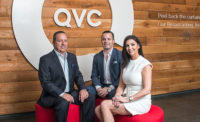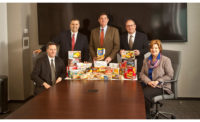Make no mistake: Monogram Foods is a proven winner. That has been demonstrated time and again in its decade-plus existence. Additionally, the company has made waves large enough in the acquisition and growth space to get everyone’s attention.
In fact, the Memphis, Tenn.-based processor of meat snacks, corn dogs, pre-cooked bacon, frozen appetizers and sandwiches, and pet treats has been a perennial contender for The National Provisioner’s Processor of the Year honor ever since it catapulted its way into the large processor category before it even celebrated its 10th anniversary. So what happened differently in 2016 that has earned Monogram Foods the 2017 Processor of the Year award?

Karl Schledwitz, chairman and CEO (who also was named one of The National Provisioner’s “25 Years, 25 Icons” in October 2016), states the top line summary well: “2016 was a transformational year for Monogram Foods. We got large enough to greatly enhance our ability to plan and grow going forward.”
A deeper dive into the last year-plus shows abundant, significant capital investment and acquisition, resulting in another year of Monogram Foods proving itself as a dominating force with which to reckon.
When The National Provisioner last visited Monogram Foods for an April 2015 cover story, the company was on its way to meeting its “Sixty in Six” target of $60 million worth of EBITDA by the end of 2017. In receiving this year’s honor, Schledwitz offered an update, saying that goal would be met, meaning a new bar had to be set.
“When you accomplish a goal, you need to set a new one,” he explains. “So our new goal basically is to double that by the year 2022 — we feel we have a very good pathway to get there.”
Historical winners,
Processor of the Year
2017: Monogram Foods
2016: Foster Farms
2015: AdvancePierre Foods
2014: Link Snacks Inc.
2013: JBS USA
2012: Land O’Frost
2011: Tyson Foods
2010: Halperns’
2009: West Liberty Foods
2008: Hormel Foods
2007: Sara Lee Food & Beverage
2006: Smithfield Foods
2005: Smithfield Foods
2004: Hormel Foods
2003: Cargill Meat Solutions
2002: Tyson Foods
2001: (Unknown; archives missing)
2000: Colorado Boxed Beef
1999: Farmland Industries Meat Group
1998: Smithfield Foods
1997: Sara Lee Meats
1996: IBP Inc.
1995: Oscar Mayer Corp.
1994: Hormel Foods
The way forward now, Schledwitz says, diverts from the primary growth path the company had followed almost exclusively its entire life.
“Turnarounds have been very good to us, so I’m not saying we won’t ever entertain doing another one,” he says. “However, going forward, our primary focus is going to be identifying family or locally owned businesses that fit strategically and are doing well.”
It’s a necessary shift for a larger company that needs acquisitions that won’t simply register as miniscule blips on the revenue radar screen.
“To maintain our current growth rate, we have to have larger acquisitions, most of which are going to be profitable when we acquire them,” Schledwitz says. “That certainly means we will have to pay more than we would for a distressed company, but the amount of money you have to invest [to turn around the business] and the time it takes to integrate will be less, so we think we have a good formula.”
Along with that good formula, Schledwitz believes Monogram’s pitch is unique and attractive — and it fits with Monogram’s longstanding corporate culture of caring about its employees and customers.
“Part of the presentation we make to family-owned businesses of why selling to Monogram makes sense is, they can roll over some of their sales proceeds into Monogram stock, be part of the Monogram growth story and get a second bite of the apple,” he explains. “They become part of the Monogram family, as opposed to selling to a larger company, where they may get swallowed up, or to private equity where they would lose control.”
Investing to grow
Like its industry peers, Monogram Foods had turned to technological advancement to reduce its reliance on labor and to attempt to gain cost advantages to stand out in the market.
“We’re not eliminating people, but we are eliminating jobs that we don’t have people to fill,” Schledwitz says. “Also, when you are a co-packer and private-label [manufacturer,] you have to be cutting edge, low-cost and innovative.”
To do that, Monogram Foods has pushed a significant amount of capital into its plants — modernizing, expanding and providing the capacity that its customers have demanded.
“We are putting a disproportionately large amount into ROIC projects,” Schledwitz adds. “We looked at what our peers were doing and we’re spending two to four times what they are, in that regard.”
The company’s Bristol, Ind., plant has benefitted from booming growth and innovation in the corn dog marketplace, and Monogram’s willingness to address those trends with strategic investment. To read more about the high-flying growth in the corn dog plant, read “Bristol: Locked and loaded.”
It has been a busy year for investments at nearly all Monogram Foods plants, and Schledwitz and Wes Jackson, Monogram Foods president, can tick off the changes made at each and every one.
Monogram began its most recent turnaround project in April 2016, when it acquired Wilmington, Mass.-based Progressive Gourmet, a processor that specializes in appetizers and specialty small-bite foods. Schledwitz explains that the turnaround is still in progress, but the company expects to quadruple revenue in 2018 out of that facility alone. Within the last year, Monogram has invested in new sandwich lines and more than doubled the number of employees in Wilmington, and Schledwitz says that Monogram will be installing another new state-of-the-art sandwich line this year.
The Wilmington business was acquired to pair with the frozen appetizer business that Monogram Foods runs out of its Plover, Wis., facility (which includes two separate plants). Plover was acquired in 2015 and has since added two new lines and hundreds of employees.
Both Plover and Wilmington represent how Monogram has begun to approach its acquisitions, says Jackson.
“Plover is what I call comfort appetizers, and Wilmington is more hors d’oeuvres, almost white-tablecloth types of products,” he says. “It gives us a broader space to play in appetizers, from comfort food to very high end, all to different targets.
“It was a natural extension of a category that we were already in, based on our abilities to sell and distribute those products,” Jackson adds.
If Monogram Foods has a “legacy” product on which it was founded, meat snacks would likely be that product. And Monogram has put itself in position to address growing demand in that category by funding major expansions and upgrades at its Martinsville, Va., plant.
Martinsville saw its footprint nearly double via expansion in early 2016, and the company also purchased an adjacent 170,000-square-foot building to consolidate and expand distribution and warehousing. Monogram also invested significantly in a new wastewater facility in Martinsville that includes capacity for future growth in meat snacks.
In Schulenburg, Texas, Monogram’s pet treats division added a wastewater facility and new smokehouse capacity in the last year that gives the company the opportunity to triple its capacity on the high-end, cleaner-label chicken jerky pet treats it produces.
Investments have also been made to expand and upgrade the company’s bacon plant in Harlan, Iowa, and original meat snacks plant in Chandler, Minn. New lines and upgraded equipment highlight those investments.
Of course, all these investments can’t operate in a vacuum, and Monogram Foods has continued to back its workforce. The company is slated to surpass 3,000 employees this year, and Jackson points out that Monogram Foods developed some new programs this year to assist employees.
“We put an emphasis on training and development, and hired 10 dedicated new positions to train and develop our team members,” he says. “We also created a new position that makes sure that throughout all the training, the Monogram culture is a big part of it.”
As Monogram Foods continues to reach for lofty goals and redefine the type of acquisitions it will need to make to drive growth, its corporate culture will never be negotiable. Sitting with Schledwitz and Jackson for any length of time will convince anyone that, above all, the company credits its employees’ buy-in and follow-through on the culture for Monogram Foods’ success over the years.
Today, while Monogram has been rewarded for an outstanding success story, the industry will be watching closely to see if the company’s strategic pivot goes smoothly and enables continued fast growth ahead. NP
Bristol: Locked and loaded
Andy Hanacek, editor-in-chief of The National Provisioner, visited Monogram Foods’ Bristol, Ind., corn dog production facility and spoke with Rob Hodgetts, plant manager, and Gary Byrd, vice president of Sales & Business Development for Monogram Foods. What follows is a portion of their conversation:
Hanacek: What are some of the successes that Bristol has experienced in the past year or two, and in your own words, how do they reflect what Monogram Foods has done as a whole?
Hodgetts: A lot of the reason for the success, frankly, is that there was a lot of investment in this plant in the form of capital assets. We put in our brand new corn dog mini line, which produces more than 4,000 pounds an hour. We commissioned that at the beginning of 2016, and then at the beginning of this year, we complemented that line with a second mini line. All in all, that was a giant investment for Monogram Foods.
We’ve also upgraded some of our personnel — finding people to come in and help us manage the business. So that’s been a big part of our success.
Byrd: If you really go back to 2012, when we first bought the facility, we had a plant in Muncie, Ind., where we had two corn dog lines that produced about 10 million pounds of product a year. We combined the two plants, and it took a while to get it perfected, aligned and built for growth. Once we got that together, we were able to go out and secure business.
We’ve got a lot of great business partners out in the marketplace, [offering] a wide breadth of items from premium corn dogs to gluten-free corn dogs, non-GMO options and other options.
Hanacek: That’s interesting to me because a lot of typical consumers wouldn’t view the corn dog as a versatile type of product, or one capable of carrying a “better for you” claim. But there are different things you can do with the corn dog concept or the corn dog itself, right? How have you been able to innovate the good old corn dog in the last year?
Hodgetts: We invested a lot, not only in the assets, but also in research and development. We realized that, in order to really penetrate the market, we had to be on the tip of the spear — have some different items to offer our customers. So we put together an R&D team here, and really started looking at what else we can do. Now, we will consider just about any idea. We even do a veggie hot dog here that’s successful. We’ve also had a lot of success with our pancake and sausage on a stick. We talk a lot about continuous improvement here. That’s not only in our procedures, in our processes, but it’s also in the product that we develop for the market.
Hanacek: What type of expansion space do you have here in Bristol?
Hodgetts: We’re pretty full within the walls, so anything else we do will require some expansion. We’ve got 40 acres here, so we have room on the grounds to expand, but we are at a sold-out capacity today. We’re currently running five, very often six days a week, and we don’t want to burn our people out. We would not have this kind of success without the people working on our floor. So, we could go to seven days a week but turnover would jump and our efficiencies would vanish as well.
Hanacek: Given that Bristol produces corn dogs and similar products, but it’s the only plant in Monogram that does it, do you often feel like your own little company?
Hodgetts: We certainly don’t feel like we’re on an island because we get a lot of support from Memphis. However, you’re right in that we are unique in our processes, and we’ve got some unique ways of measuring our performance. Our team is very attuned to “being in the green,” meaning running at rate — a standard rate that’s pretty much the same every single day. If I look up at my screen here in my office, I can tell you every hour — or even every 15 minutes — if we’re making a rate on that line or not. And we have these screens in the plant, so the entire team is aware every minute whether they’re making rate or not making rate.
Byrd: To Rob’s point, I think we’re very connected. Even though we’re unique, we’re still connected in many, many ways, with customer service in Memphis and a lot of connection between shipping and R&D.
Hanacek: Talk about the quarterly town halls you hold with the employees: Where did that come from and how has that evolved over time?
Hodgetts: Well, that really starts with Karl [Schledwitz,] because he does a quarterly town hall with the entire executive group. We took that model and rolled it out here in Bristol. We just followed our leader’s model; we talk about where we’re going with the company and very often give out rewards — service rewards, and things like that.
Today, we’re going to be celebrating a record year in 2016 for us at 50 million pounds. Our goal for 2017 is 60 million pounds, and when I got here in 2014, they were at 38 million pounds. We can’t win without our people, so they’ll get a token of our appreciation today. We’ll feed them and talk about where we’re going and how we’re going to develop the folks on the floor to take them to the next level.
Hanacek: You mentioned earlier that there was a learning curve with the first corn dog mini line. Was that learning curve centered around the size of the line or the process specifically?
Hodgetts: We used to make our minis in our kitchen using a batch process. So fairly early on, senior leadership realized we needed to improve. So we installed [the new mini line] with additional automation. While it was quite an investment, it allows us to hit some rates that potentially our competitors can’t. It also allows us to make a product that is stable and uniform from piece to piece to piece. Because of the newness of the process to us, there were a lot of challenges. We had to learn the process and that took a lot of time. We developed an entire manual on our own of how to run that mini line. Just about a year ago [May 2016], we really got it locked in as a repeatable process at a standard rate.
We installed the second mini line and turned the key on Jan. 7, 2017. I believe it was the third week of January, when we were running at rate. So we shrunk that learning curve down from just about six months to three weeks.
Hanacek: What are the plans for this plant moving forward that you can share? What are you working on?
Hodgetts: I see us continuing to develop the process that we have in place and the people that we have in place in order to gain the efficiencies we need. In order to remain competitive in the marketplace, we’ve got to continually improve our process and our efficiencies. We’re also looking at some further automation.
We’d also like to mirror our mini process for full-sized hot dogs and sausages.
Byrd: From the customers’ side, our continuous improvement [effort] leads to reduction of complaints. We’re judged by a lot of our customers with either complaints per million or just total complaints annually. In the last 18-24 months, we’ve had a very nice decrease in complaints per million. That’s the No. 1 thing, if the customer is pleased with our quality and the consumer likes the product, it sure helps us sell more products. NP








Report Abusive Comment